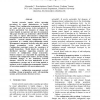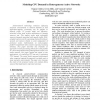DANCE
2002
IEEE
14 years 6 months ago
2002
IEEE
Modeling and formally analyzing active network systems and protocols is quite challenging, due to their highly dynamic nature and the need for new network models. We propose a wid...
DANCE
2002
IEEE
14 years 6 months ago
2002
IEEE
DANCE
2002
IEEE
14 years 6 months ago
2002
IEEE
This paper describes the design, implementation and performance of an open, high performance, dynamically extensible router under development at Washington University in St. Louis...
DANCE
2002
IEEE
14 years 6 months ago
2002
IEEE
Current networks require ad-hoc operating procedures by expert administrators to handle changes. These configuration management operations are costly and error prone. Active netwo...
DANCE
2002
IEEE
14 years 6 months ago
2002
IEEE
This paper describes the activities in Application Level Active Networks (ALAN) under the DARPA-funded RADIOACTIVE Project; this is closely related to work carried out under a Eur...
DANCE
2002
IEEE
14 years 6 months ago
2002
IEEE
Active applications can add value to communication. Yet it involves sophisticated domain knowledge and complex development process. In this paper we discuss a framework for the co...
DANCE
2002
IEEE
14 years 6 months ago
2002
IEEE
We present the architecture, design, and implementation of a Smart Environment for Network Control, Monitoring and Management (SENCOMM). SENCOMM uses active network technology to ...
DANCE
2002
IEEE
14 years 6 months ago
2002
IEEE
Active Networking adds programmability to the elements of the network, most aggressively by using programmable packets, or capsules. ANTS [1, 2] and PLANet [3, 4] are the most mat...
DANCE
2002
IEEE
14 years 6 months ago
2002
IEEE
— Active Networks, being programmable, promise greater flexibility than current networks. Programmability, however, may introduce safety and security risks. This paper describes...
DANCE
2002
IEEE
14 years 6 months ago
2002
IEEE
Active-network technology envisions deploying execution environments in network elements so that application-specific processing can be applied to network traffic. To provide safe...


